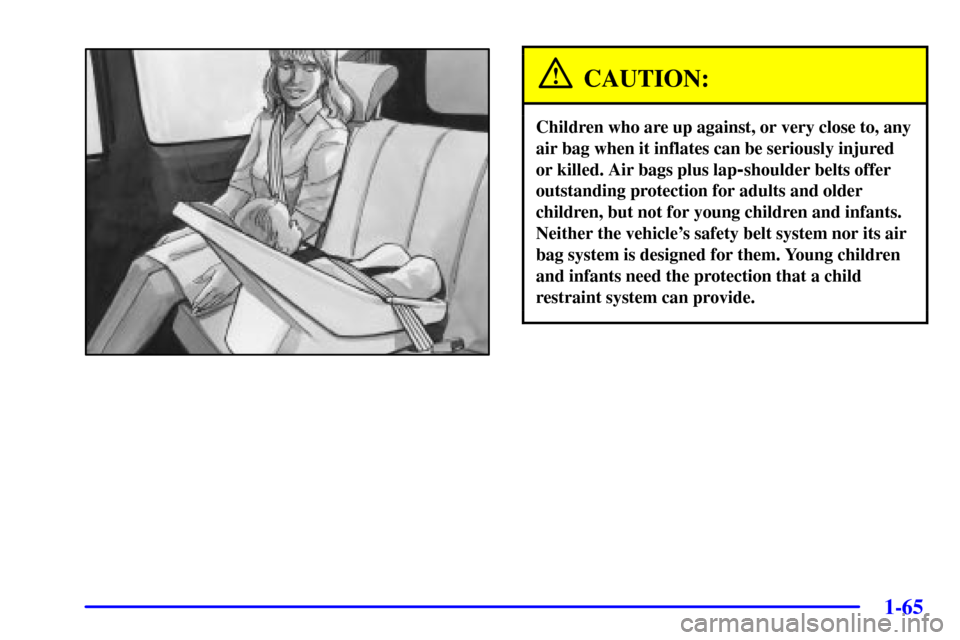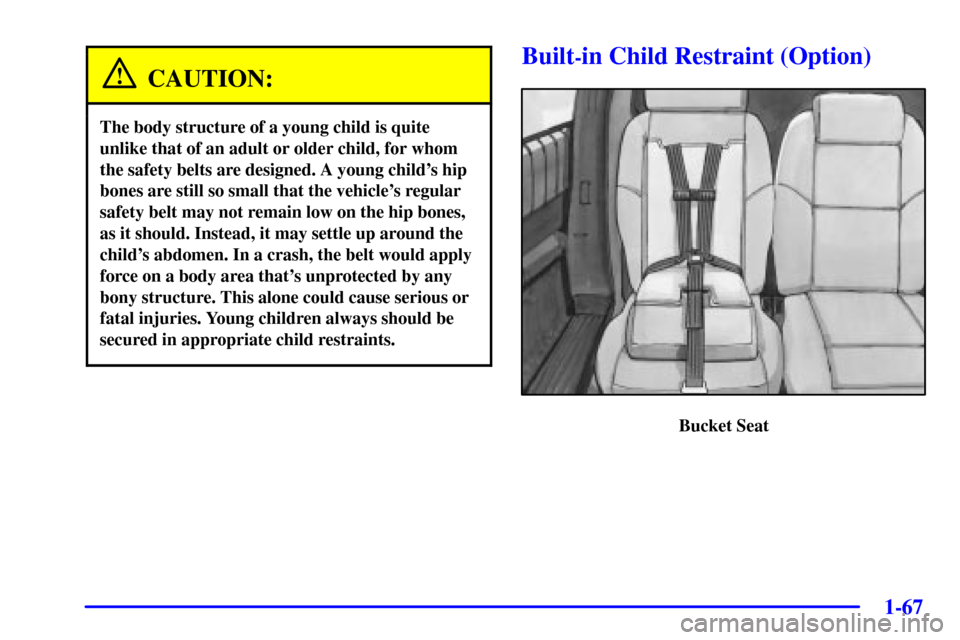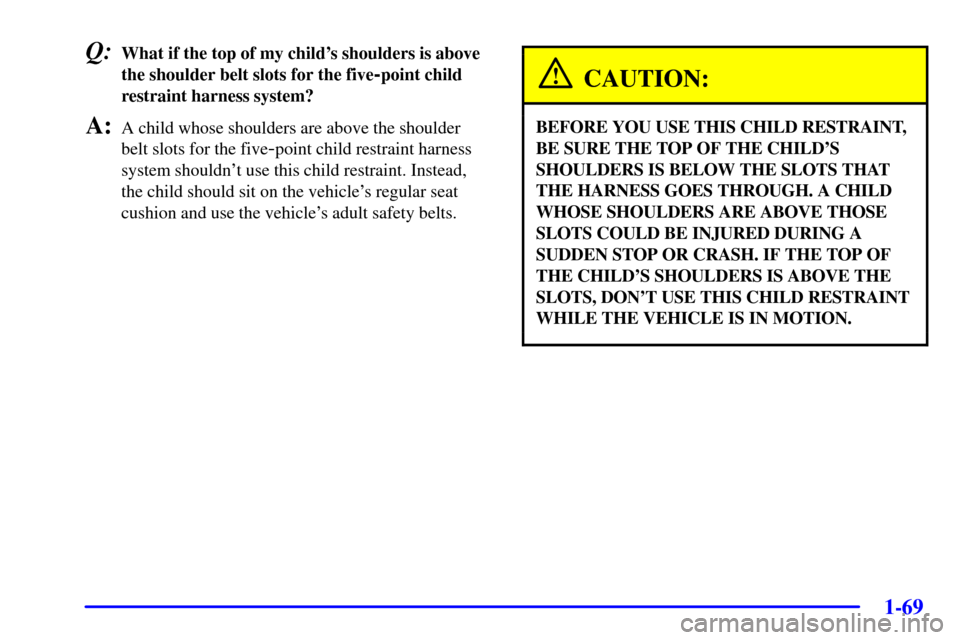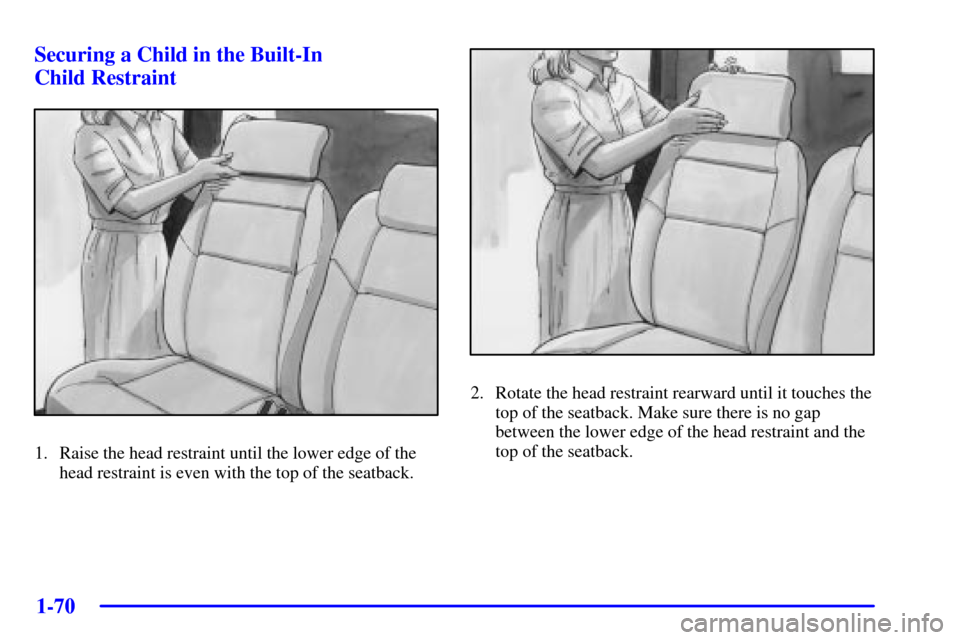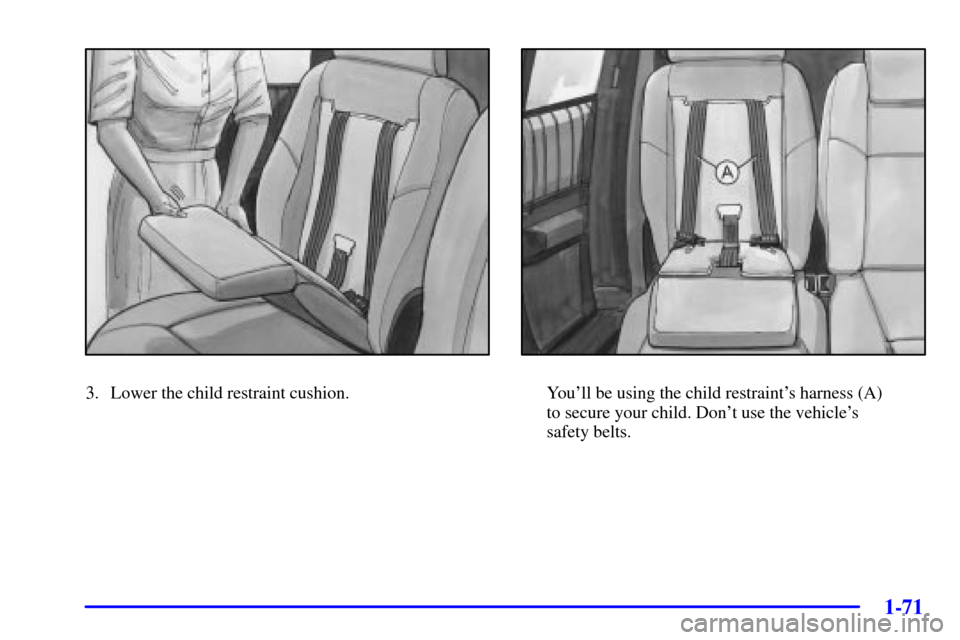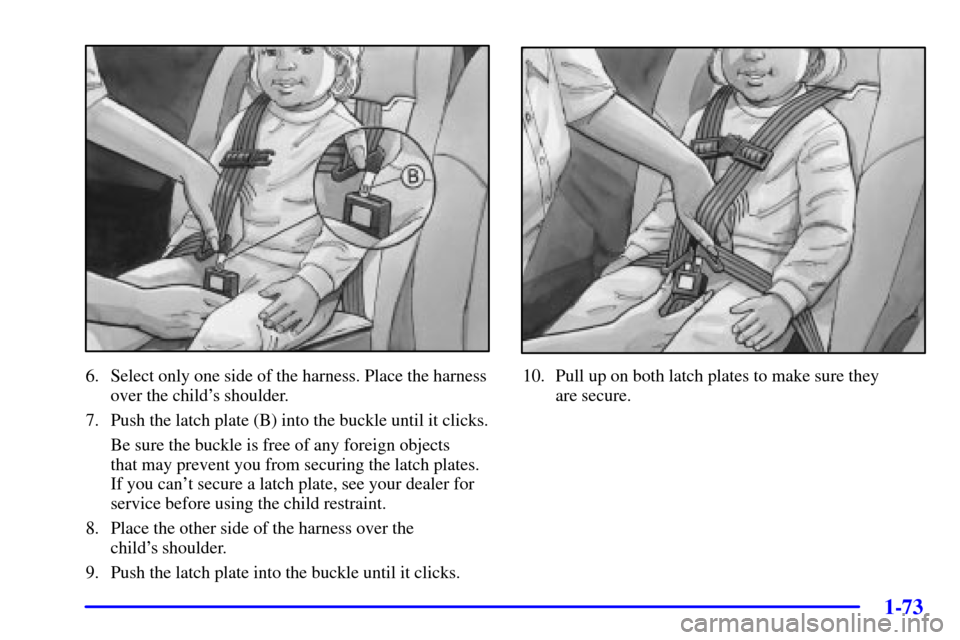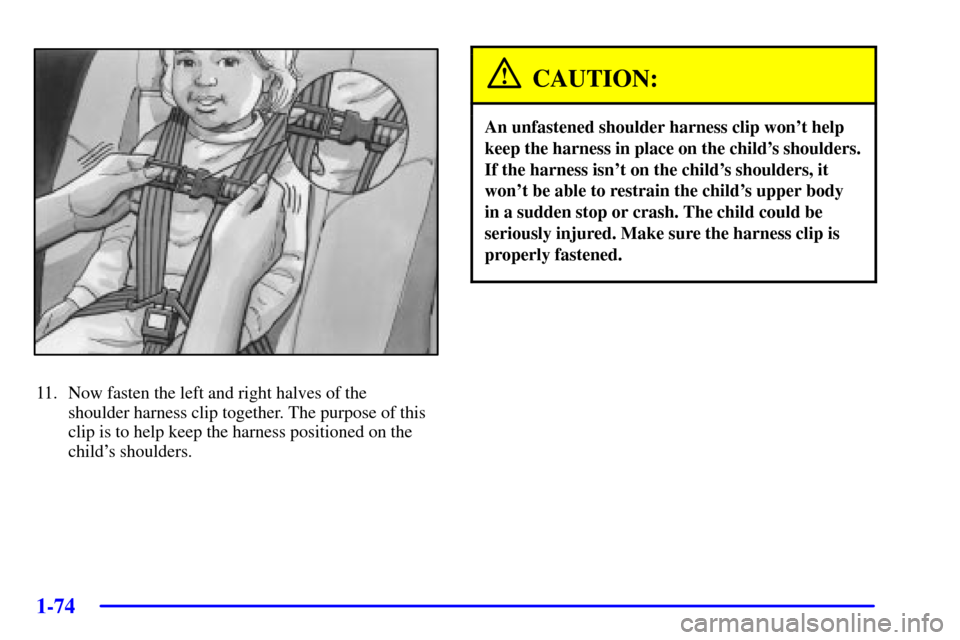CHEVROLET VENTURE 2002 1.G Manual PDF
VENTURE 2002 1.G
CHEVROLET
CHEVROLET
https://www.carmanualsonline.info/img/24/8379/w960_8379-0.png
CHEVROLET VENTURE 2002 1.G Manual PDF
Trending: display, boot, belt, alarm, parking sensors, clock setting, spare wheel
Page 71 of 486
1-65
CAUTION:
Children who are up against, or very close to, any
air bag when it inflates can be seriously injured
or killed. Air bags plus lap
-shoulder belts offer
outstanding protection for adults and older
children, but not for young children and infants.
Neither the vehicle's safety belt system nor its air
bag system is designed for them. Young children
and infants need the protection that a child
restraint system can provide.
Page 72 of 486
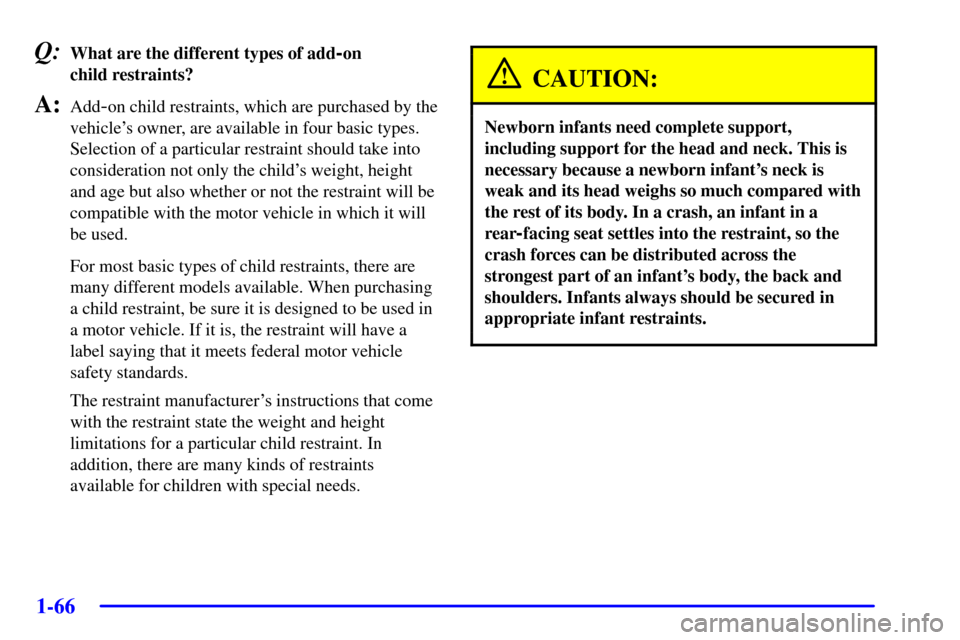
1-66
Q:What are the different types of add-on
child restraints?
A:Add-on child restraints, which are purchased by the
vehicle's owner, are available in four basic types.
Selection of a particular restraint should take into
consideration not only the child's weight, height
and age but also whether or not the restraint will be
compatible with the motor vehicle in which it will
be used.
For most basic types of child restraints, there are
many different models available. When purchasing
a child restraint, be sure it is designed to be used in
a motor vehicle. If it is, the restraint will have a
label saying that it meets federal motor vehicle
safety standards.
The restraint manufacturer's instructions that come
with the restraint state the weight and height
limitations for a particular child restraint. In
addition, there are many kinds of restraints
available for children with special needs.
CAUTION:
Newborn infants need complete support,
including support for the head and neck. This is
necessary because a newborn infant's neck is
weak and its head weighs so much compared with
the rest of its body. In a crash, an infant in a
rear
-facing seat settles into the restraint, so the
crash forces can be distributed across the
strongest part of an infant's body, the back and
shoulders. Infants always should be secured in
appropriate infant restraints.
Page 73 of 486
1-67
CAUTION:
The body structure of a young child is quite
unlike that of an adult or older child, for whom
the safety belts are designed. A young child's hip
bones are still so small that the vehicle's regular
safety belt may not remain low on the hip bones,
as it should. Instead, it may settle up around the
child's abdomen. In a crash, the belt would apply
force on a body area that's unprotected by any
bony structure. This alone could cause serious or
fatal injuries. Young children always should be
secured in appropriate child restraints.
Built-in Child Restraint (Option)
Bucket Seat
Page 74 of 486
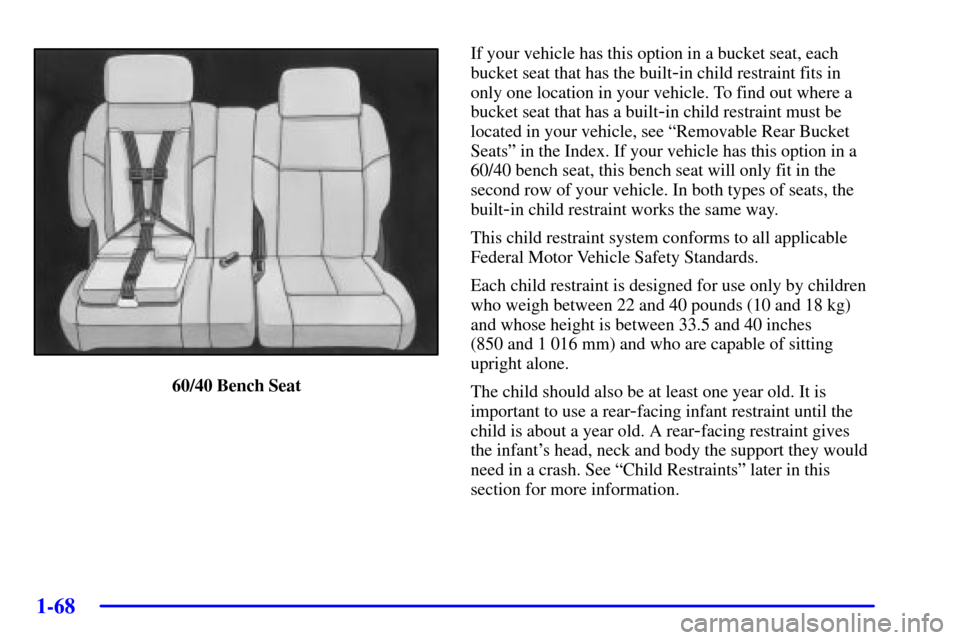
1-68
60/40 Bench SeatIf your vehicle has this option in a bucket seat, each
bucket seat that has the built
-in child restraint fits in
only one location in your vehicle. To find out where a
bucket seat that has a built
-in child restraint must be
located in your vehicle, see ªRemovable Rear Bucket
Seatsº in the Index. If your vehicle has this option in a
60/40 bench seat, this bench seat will only fit in the
second row of your vehicle. In both types of seats, the
built
-in child restraint works the same way.
This child restraint system conforms to all applicable
Federal Motor Vehicle Safety Standards.
Each child restraint is designed for use only by children
who weigh between 22 and 40 pounds (10 and 18 kg)
and whose height is between 33.5 and 40 inches
(850 and 1 016 mm) and who are capable of sitting
upright alone.
The child should also be at least one year old. It is
important to use a rear
-facing infant restraint until the
child is about a year old. A rear
-facing restraint gives
the infant's head, neck and body the support they would
need in a crash. See ªChild Restraintsº later in this
section for more information.
Page 75 of 486
1-69
Q:What if the top of my child's shoulders is above
the shoulder belt slots for the five
-point child
restraint harness system?
A:A child whose shoulders are above the shoulder
belt slots for the five
-point child restraint harness
system shouldn't use this child restraint. Instead,
the child should sit on the vehicle's regular seat
cushion and use the vehicle's adult safety belts.
CAUTION:
BEFORE YOU USE THIS CHILD RESTRAINT,
BE SURE THE TOP OF THE CHILD'S
SHOULDERS IS BELOW THE SLOTS THAT
THE HARNESS GOES THROUGH. A CHILD
WHOSE SHOULDERS ARE ABOVE THOSE
SLOTS COULD BE INJURED DURING A
SUDDEN STOP OR CRASH. IF THE TOP OF
THE CHILD'S SHOULDERS IS ABOVE THE
SLOTS, DON'T USE THIS CHILD RESTRAINT
WHILE THE VEHICLE IS IN MOTION.
Page 76 of 486
1-70 Securing a Child in the Built-In
Child Restraint
1. Raise the head restraint until the lower edge of the
head restraint is even with the top of the seatback.
2. Rotate the head restraint rearward until it touches the
top of the seatback. Make sure there is no gap
between the lower edge of the head restraint and the
top of the seatback.
Page 77 of 486
1-71
3. Lower the child restraint cushion.You'll be using the child restraint's harness (A)
to secure your child. Don't use the vehicle's
safety belts.
Page 78 of 486
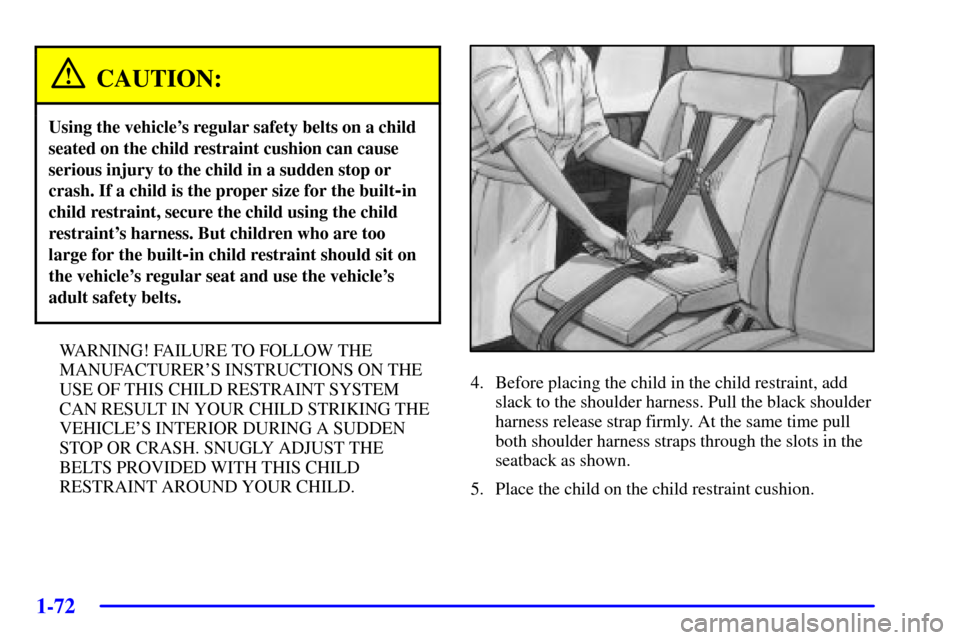
1-72
CAUTION:
Using the vehicle's regular safety belts on a child
seated on the child restraint cushion can cause
serious injury to the child in a sudden stop or
crash. If a child is the proper size for the built
-in
child restraint, secure the child using the child
restraint's harness. But children who are too
large for the built
-in child restraint should sit on
the vehicle's regular seat and use the vehicle's
adult safety belts.
WARNING! FAILURE TO FOLLOW THE
MANUFACTURER'S INSTRUCTIONS ON THE
USE OF THIS CHILD RESTRAINT SYSTEM
CAN RESULT IN YOUR CHILD STRIKING THE
VEHICLE'S INTERIOR DURING A SUDDEN
STOP OR CRASH. SNUGLY ADJUST THE
BELTS PROVIDED WITH THIS CHILD
RESTRAINT AROUND YOUR CHILD.
4. Before placing the child in the child restraint, add
slack to the shoulder harness. Pull the black shoulder
harness release strap firmly. At the same time pull
both shoulder harness straps through the slots in the
seatback as shown.
5. Place the child on the child restraint cushion.
Page 79 of 486
1-73
6. Select only one side of the harness. Place the harness
over the child's shoulder.
7. Push the latch plate (B) into the buckle until it clicks.
Be sure the buckle is free of any foreign objects
that may prevent you from securing the latch plates.
If you can't secure a latch plate, see your dealer for
service before using the child restraint.
8. Place the other side of the harness over the
child's shoulder.
9. Push the latch plate into the buckle until it clicks.10. Pull up on both latch plates to make sure they
are secure.
Page 80 of 486
1-74
11. Now fasten the left and right halves of the
shoulder harness clip together. The purpose of this
clip is to help keep the harness positioned on the
child's shoulders.
CAUTION:
An unfastened shoulder harness clip won't help
keep the harness in place on the child's shoulders.
If the harness isn't on the child's shoulders, it
won't be able to restrain the child's upper body
in a sudden stop or crash. The child could be
seriously injured. Make sure the harness clip is
properly fastened.
Trending: oil reset, ECU, set clock, instrument panel, battery capacity, power steering, seat adjustment
